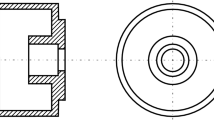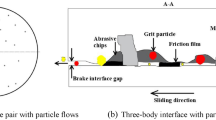Abstract
Braking is an energy dissipation mechanism used to restrict the movement of vehicles. Friction brakes may induce vibrations and noise. These effects constitute a major shortcoming related to the functioning of friction braking systems. Known as brake squeal, this phenomenon involves unstable vibrations induced by coupling modes between components in frictional contact leading to large amplitude vibrations. Despite significant progress in experimental techniques and numerical modeling, the origin of squeal occurrence remains misunderstood and is still a matter of debate. It is, however, commonly admitted that squeal is affected by many different factors on both micro and macro scales. In addition, a close correlation between wear and squeal occurrence in braking system has been reported. This study examines linking the change in the third-body layer with the occurrence of squeals in sliding dry contact. A simplified customized test rig was used with a transparent glass disc and an artificial alumina third-body. Results show that squeal occurrence is strongly linked to the densification and redistribution of the third-body, as well as internal flows in the interface.








Similar content being viewed by others
Abbreviations
- Qs (ext):
-
External third-body source flow
- Qs (int):
-
Internal third-body source flow
- Qe :
-
Particles wear-out
- Qr :
-
Third-body recirculation flow
- Qi :
-
Internal third-body flow
References
Dufrénoy, P., Bodovillé, G., Degallaix, G.: Damage mechanisms and thermomechanical loading of brake discs. Eur. Struct. Integr. Soc. 29, 167–176 (2002). https://doi.org/10.1016/S1566-1369(02)80073-5
Lee, K., Barber, J.R.: An experimental investigation of frictionally-excited thermoelastic instability in automotive disk brakes under a drag brake application. J. Tribol. 116, 409–414 (1994)
Österle, W., Dörfel, I., Prietzel, C., Rooch, H., Cristol-Bulthé, A.-L., Degallaix, G., Desplanques, Y.: A comprehensive microscopic study of third body formation at the interface between a brake pad and brake disc during the final stage of a pin-on-disc test. Wear 267, 781–788 (2009). https://doi.org/10.1016/j.wear.2008.11.023
Kasem, H., Bonnamy, S., Rousseau, B., Estrade-Szwarckopf, H., Berthier, Y., Jacquemard, P.: Interdependence between wear process, size of detached particles and CO2 production during carbon/carbon composite friction. Wear 263, 1220–1229 (2007). https://doi.org/10.1016/j.wear.2007.01.077
Ozcan, S., Filip, P.: Microstructure and wear mechanisms in C/C composites. Wear 259, 642–650 (2005). https://doi.org/10.1016/j.wear.2005.02.112
Mortelette, L., Brunel, J.F., Boidin, X., Desplanques, Y., Dufrénoy, P., Smeets, L.: Impact of mineral fibres on brake squeal occurrences. SAE International 2009 Brake Colloquium and Exhibition. SAE International, USA (2009). https://doi.org/10.4271/2009-01-3050
Massi, F., Berthier, Y., Baillet, L.: Contact surface topography and system dynamics of brake squeal. Wear 265, 1784–1792 (2008). https://doi.org/10.1016/j.wear.2008.04.049
Akay, A.: Acoustics of friction. J. Acoust. Soc. Am. 111, 1525 (2002). https://doi.org/10.1121/1.1456514
Massi, F., Baillet, L., Giannini, O., Sestieri, A.: Brake squeal: linear and nonlinear numerical approaches. Mech. Syst. Signal Process. 21, 2374–2393 (2007). https://doi.org/10.1016/j.ymssp.2006.12.008
Kinkaid, N.M., O’Reilly, O.M., Papadopoulos, P.: Automotive disc brake squeal. J. Sound Vib. 267, 105–166 (2003). https://doi.org/10.1016/S0022-460X(02)01573-0
Ouyang, H., Nack, W., Yuan, Y., Chen, F.: Numerical analysis of automotive disc brake squeal: a review. Int. J. Veh. Noise Vib. 1, 207–231 (2005). https://doi.org/10.1504/IJVNV.2005.007524
Giannini, O., Akay, A., Massi, F.: Experimental analysis of brake squeal noise on a laboratory brake setup. J. Sound Vib. 292, 1–20 (2006). https://doi.org/10.1016/j.jsv.2005.05.032
Conglin, D., Jiliang, M., Chengqing, Y., Xiuqin, B., Tian, Y.: Vibration and noise behaviors during stick—slip friction. Tribol. Lett. (2019). https://doi.org/10.1007/s11249-019-1216-1
Massi, F., Giannini, O., Baillet, L.: Brake squeal as dynamic instability: an experimental investigation. J. Acoust. Soc. Am. 120, 1388–1398 (2006). https://doi.org/10.1121/1.2228745
Bonnay, K., Magnier, V., Brunel, J.F., Dufrénoy, P., De Saxcé, G.: Influence of geometry imperfections on squeal noise linked to mode lock-in. Int. J. Solids Struct. 75–76, 99–108 (2015). https://doi.org/10.1016/j.ijsolstr.2015.08.004
Godet, M.: The third-body approach: A mechanical view of wear. Wear 100, 437–452 (1984). https://doi.org/10.1016/0043-1648(84)90025-5
Berthier, Y.: Maurice Godet’s third body. Tribol. Ser. 31, 21–30 (1996). https://doi.org/10.1016/S0167-8922(08)70766-1
Jacko, M.G., Tsang, P.H.S., Rhee, S.K.: Wear debris compaction and friction film formation of polymer composites. Wear 133, 23–38 (1989). https://doi.org/10.1016/0043-1648(89)90110-5
Österle, W., Urban, I.: Friction layers and friction films on PMC brake pads. Wear 257, 215–226 (2004). https://doi.org/10.1016/j.wear.2003.12.017
Eriksson, M., Lord, J., Jacobson, S.: Wear and contact conditions of brake pads: dynamical in situ studies of pad on glass. Wear 249, 272–278 (2001). https://doi.org/10.1016/S0043-1648(01)00573-7
Desplanques, Y., Degallaix, G.: Interactions between third-body flows and localisation phenomena during railway high-energy stop braking. SAE Int. J. Passeng. Cars Mech. Syst. 1, 1267–1275 (2008). https://doi.org/10.4271/2008-01-2583
Desplanques, Y., Degallaix, G.: Genesis of the third-body at the pad-disc interface: case study of sintered metal matrix composite lining material. SAE Int. J. Mater. Manf. 2, 25–32 (2009). https://doi.org/10.4271/2009-01-3053
Lee, S., Jang, H.: Effect of plateau distribution on friction instability of brake friction materials. Wear 400–401, 1–9 (2018). https://doi.org/10.1016/j.wear.2017.12.015
Bergman, F., Eriksson, M., Jacobson, S.: Influence of disc topography on generation of brake squeal. Wear 225–229, 621–628 (1999). https://doi.org/10.1016/S0043-1648(99)00064-2
Rhee, S.K., Jacko, M.G., Tsang, P.H.S.: The role of friction film in friction, wear and noise of automotive brakes. Wear 146, 89–97 (1991). https://doi.org/10.1016/0043-1648(91)90226-K
Hetzler, H., Willner, K.: On the influence of contact tribology on brake squeal. Tribol. Int. 46, 237–246 (2012). https://doi.org/10.1016/j.triboint.2011.05.019
Magnier, V., Naidoo Ramasami, D., Brunel, J.F., Dufrénoy, P., Chancelier, T.: History effect on squeal with a mesoscopic approach to friction materials. Tribol. Int. 115, 600–607 (2017). https://doi.org/10.1016/j.triboint.2017.06.031
Richard, D., Iordanoff, I., Renouf, M., Berthier, Y.: Thermal study of the dry sliding contact with third body presence. J. Tribol. 130, 031404 (2008). https://doi.org/10.1115/1.2913540
Müller, M., Ostermeyer, G.P.: A Cellular Automaton model to describe the three-dimensional friction and wear mechanism of brake systems. Wear 263, 1175–1188 (2007). https://doi.org/10.1016/j.wear.2006.12.022
Ostermeyer, G.P., Müller, M.: New insights into the tribology of brake systems. Proc. Inst. Mech. Eng. Part D 222, 1167–1200 (2008).https://doi.org/10.1243/09544070JAUTO595
Österle, W., Orts-gil, G., Gross, T., Deutsch, C., Hinrichs, R., Vasconcellos, M.A.Z.: Impact of high energy ball milling on the nanostructure of magnetite—graphite and magnetite—graphite—molybdenum disulphide blends. Mater. Charact. 86, 28–38 (2013). https://doi.org/10.1016/j.matchar.2013.09.007
Dmitriev, A. I., Österle, W.: Modelling the sliding behaviour of tribofilms forming during automotive braking: impact of loading parameters and property range of constituents. Tribol. Lett. 53, 337–351 (2013). https://doi.org/10.1007/s11249-013-0274-z
Magnier, V., Brunel, J.F., Dufrénoy, P.: Impact of contact stiffness heterogeneities on friction-induced vibration. Int. J. Solids Struct. 51, 1662–1669 (2014). https://doi.org/10.1016/j.ijsolstr.2014.01.005
Kasem, H., Bonnamy, S., Berthier, Y., Jacquemard, P.: Characterization of surface grooves and scratches induced by friction of C/C composites at low and high temperatures. Tribol. Int. 43, 1951–1959 (2010). https://doi.org/10.1016/j.triboint.2010.03.004
Cristol-Bulthé, A.-L., Desplanques, Y., Degallaix, G.: Coupling between friction physical mechanisms and transient thermal phenomena involved in pad–disc contact during railway braking. Wear 263, 1230–1242 (2007). https://doi.org/10.1016/j.wear.2006.12.052
Davin, E., Cristol, A., Brunel, J., Desplanques, Y.: Wear mechanisms alteration at braking interface through atmosphere modification. Wear 426–427, 1094–1101 (2019). https://doi.org/10.1016/j.wear.2019.01.057
Duboc, M., Magnier, V., Brunel, J., Dufrénoy, P., Chancelier, T.: Influence of contact conditions and pad geometry on disc brake squeal noise. In: European Conference on Braking, JEF2010. pp. 247–254 (2010)
Acknowledgements
The present research work has been supported by the ELSAT2020 project co-financed by the European Union with the European Regional Development Fund, the French State and the Hauts de France Region Council. The authors gratefully acknowledge the support of these institutions.
Author information
Authors and Affiliations
Corresponding author
Additional information
Publisher's Note
Springer Nature remains neutral with regard to jurisdictional claims in published maps and institutional affiliations.
Rights and permissions
About this article
Cite this article
Singla, N., Brunel, JF., Mège-Revil, A. et al. Experiment to Investigate the Relationship Between the Third-Body Layer and the Occurrence of Squeals in Dry Sliding Contact. Tribol Lett 68, 4 (2020). https://doi.org/10.1007/s11249-019-1244-x
Received:
Accepted:
Published:
DOI: https://doi.org/10.1007/s11249-019-1244-x




